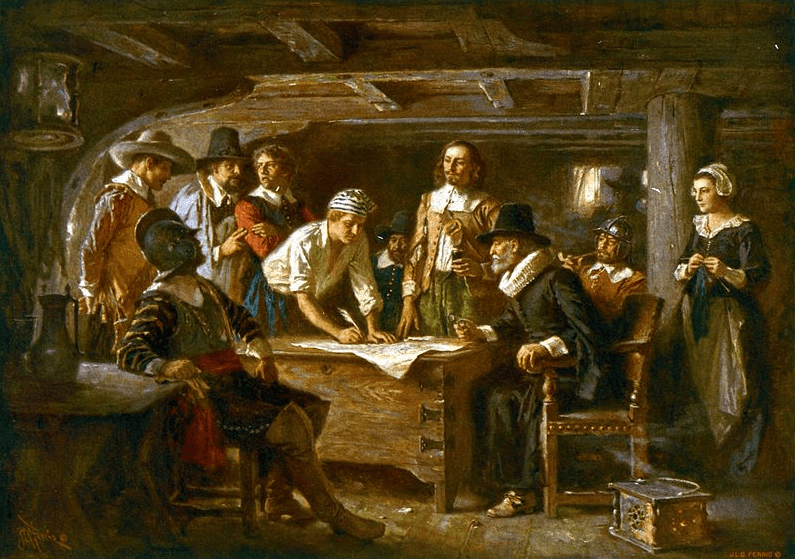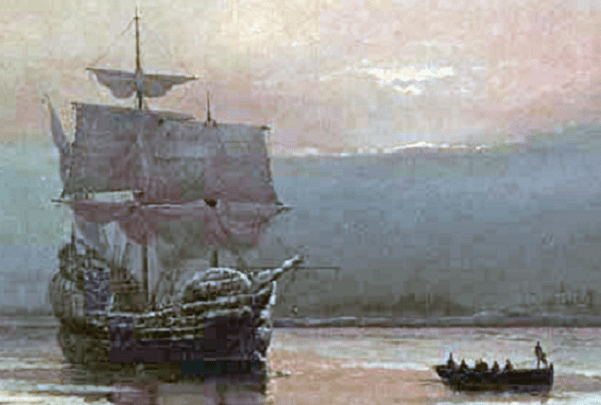Although we all can remember some of the American history we were taught in school, including the Pilgrims arriving in America onboard the Mayflower in 1620, you may not recall what the Mayflower Compact was.

The answer – and its implications – are quite fascinating.
The Mayflower Compact was a document signed on 21 November 1620 by adult male passengers of the Mayflower. It was signed directly on the English ship before the Pilgrims landed at Plymouth, Massachusetts. It was the first framework for any sort of government enacted on the territory we now know as the United States of America.
Setting the Scene: Why Was the Mayflower Compact Needed?
So, what was the purpose of the Mayflower Compact – what were the reasons why it was necessary in the first place?
Due to extremely rough weather during the Atlantic crossing, storms and seas pushed the Mayflower off course, away from its intended destination at the mouth of the Hudson River and toward Cape Cod, a yet unclaimed region of the new terrain. Passengers were now no longer in the jurisdiction of the land charter that had granted them the right to settle in the new territory, which had been granted in England by the Virginia Company.
From this jurisdictional issue arose a legally uncertain situation that caused friction between the Pilgrims – the Puritan Separatists – and the rest of their fellow travelers. Some of the non-Puritans even threatened to leave the others and settle by themselves. Under the difficult conditions of trying to establish a new colony, this sort of disarray could not be tolerated.
Who Wrote the Mayflower Compact?
To preserve unity among the quarrelling passengers of the Mayflower, Pilgrim leaders like William Bradford drafted the Mayflower Compact to quell the conflict. This 200-word document formed its signers into what is called a body politic. This bound them to abide by the laws and regulations that leaders deemed were good for the overall community.
Signers of the Mayflower Compact
How many people were on the Mayflower and who signed the contract? The Mayflower Compact was signed by almost every adult male passenger on the Mayflower – 41 out of 102 total passengers.
Although the original Mayflower Compact was lost, the earliest known version of this important document still exists. It was printed, along with the names of its signers, in a 1622 book called Mourt’s Relation by Edward Winslow and William Bradford, which chronicled the oftentimes harrowing story of Plymouth’s settlement.
The following are names of the 41 signers of the Mayflower Compact.
Could one of them be your ancestor?
- John Carver
- William Bradford
- Edward Winslow
- William Brewster
- Issac Allerton
- Myles Standish
- John Alden
- Samuel Fuller
- Christopher Martin
- William Mullins
- William White
- Richard Warren
- John Howland
- Stephen Hopkins
- Edward Tilley
- John Tilley
- Francis Cooke
- Thomas Rogers
- Thomas Tinker
- John Rigdale
- Edward Fuller
- John Turner
- Francis Eaton
- James Chilton
- John Crackston
- John Billington
- Moses Fletcher
- John Goodman
- Degory Priest
- Thomas Williams
- Gilbert Winslow
- Edmund Margeson
- Peter Browne
- Richard Britteridge
- George Soule
- Richard Clarke
- Richard Gardiner
- John Allerton
- Thomas English
- Edward Dotey
- Edward Leister
If any of these seem connected to you, just search on their names in GenealogyBank’s Historical Newspaper Archives. You’ll not only find historical articles about these colonists written after the fact, but searching on their names will turn up obituaries of their descendants – a connection back to one of the Mayflower passengers is often highlighted in descendants’ obituaries.
Importance of the Mayflower Compact
Although it was not a constitution, the Mayflower Compact was incredibly important for future American governance. It established the early principles of common consent and self-government, which would kickstart the establishment of democracy in the young country. It was an adaptation of a Puritan church covenant, applied to civil matters rather than holy ones.
Although this document did not actually improve the legality of the Pilgrims’ rights to settle in the Cape Cod area – that would be done in June of 1621 through a patent from the Council for New England – the Mayflower Compact did serve as a provisional instrument for the new settlers, and established the foundation for Plymouth’s government until its absorption by the Massachusetts Bay Colony in 1691.
Were Your Ancestors Involved?
With the help of our massive archive of more than 2 billion newspaper records, from 1690 to the present, GenealogyBank can help you unearth the untold stories of your ancestors. If you suspect that you may be related to the men who wrote and signed this compact, or any of the other passengers on the Mayflower, your ancestors’ stories are in the paper.
With the help of our resources, you can conveniently sift through a ton of records from GenealogyBank’s 13,000+ newspapers and 260 million obituaries, 95% of which are exclusive to GenealogyBank. Here’s how:
- Simply enter an ancestor’s last name to search the vast newspaper archive for clues.
- Use robust filters like keywords, location, newspaper, proximity, and date to narrow down your search.
- Save and arrange your findings, create to-do lists, and connect with other family members to discover even more.
- Were your ancestors involved in the Mayflower Compact? Click here to find out.
Find Your Connection to the Mayflower Compact
Clearly, the Mayflower Compact was a groundbreaking document for its time – and for American history. Not only was it the text that allowed the first Pilgrims to settle in New England, but it also set up a foundation for future government in the United States. On top of that – if that isn’t exciting enough – you could be descended from one of these brave writers, signers, or Pilgrims!
Explore our resources at GenealogyBank to uncover your truth today.
Sources:
- Britannica: Mayflower Compact
- Plimoth Plantation: Mayflower and Mayflower Compact
- U.S. History: The Mayflower Compact
Related Articles:
